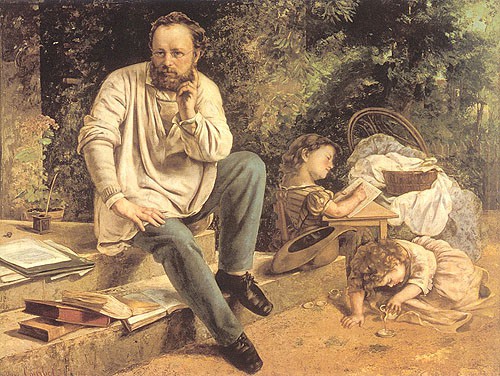A decidedly independent and provocative artist, Gustave Courbet built his reputation in defiance of the imperial regime. And his success came as much from the scandals which he repeatedly provoked by his paintings at the Salons as with the combative relations which he had with the administrators of French Fine Arts. Through his extraordinary temperament and huge ego, he faced off 'the powers that were' without fear, refusing commissions and sales, organising his own personal exhibition on the fringes of the Universal Exhibitions of 1855 and of 1867 and, his supreme act of hubris, refusing membership of the Légion d'honneur in 1870. In view of his complete detachment from the institutional art world of the period and the development of his own personal distribution network, his career looks remarkably modern.
Courbet presented this portrait of Proudhon at the Salon of 1865, an homage not only to the renowned anarco-socialist political theorist but also to a friend who had just died. Both men came from the French region of Franche-Comté and both shared the same political outlook. Courbet, an ardent republican, had been derided since 1850 for his kitchen-sink themes. Indeed his nitty-gritty (and critical) realism, for which he was the premier exponent, had brought him severe criticism – his subjects were working class and his manner was «ugly, dirty and vulgar». Prudhon's last work, Du principe de l'art et de sa destination sociale (On the principal of art and its social application), published posthumously, was similarly critical of Second Empire society and furthermore made direct reference to the painter.
Using photographs in his composition of the work, Courbet painted his friend in an intimate family moment. The date chosen, 1853, is that when Proudhon was released from prison – he had been incarcerated in 1849 for having defended his ideas in print. Proudhon is sitting upon some steps, the books and papers of his work beside him, apparently staring at the viewer. The peasant shirt he is wearing, given to him by a fellow inmate, is given the double symbolic charge of working class origins and political struggle. Whilst Proudhon's wife was also once in the picture, sitting sewing behind her children, Courbet subsequently painted her out when he re-painted the work after 1866, simply leaving an empty chair. The composition thereby recentred on Proudhon thus became a manifesto in honour of the man whom Courbet called the «pilot of the 19th century».
Karine Huguenaud (trans P.H.)
February 2003
Pierre-Joseph Proudhon and his children in 1853
Artist(s) : COURBET Gustave

- Date :
- 1865
- Technique :
- oil on canvas
- Dimensions :
- H = 1.47 m, L = 1.98 m
- Place held :
- Paris, Musée du Petit Palais

